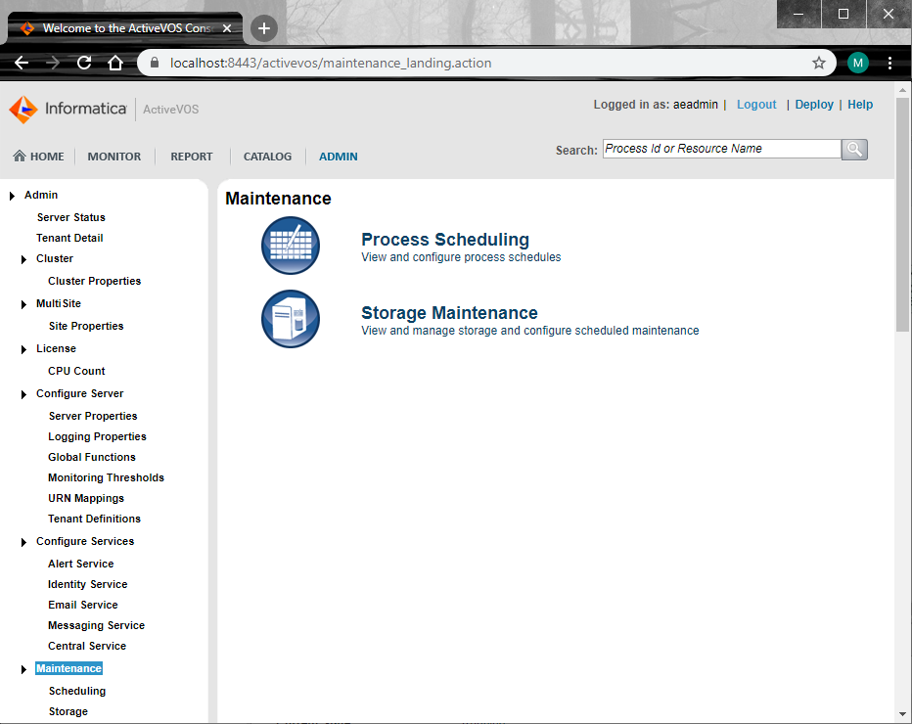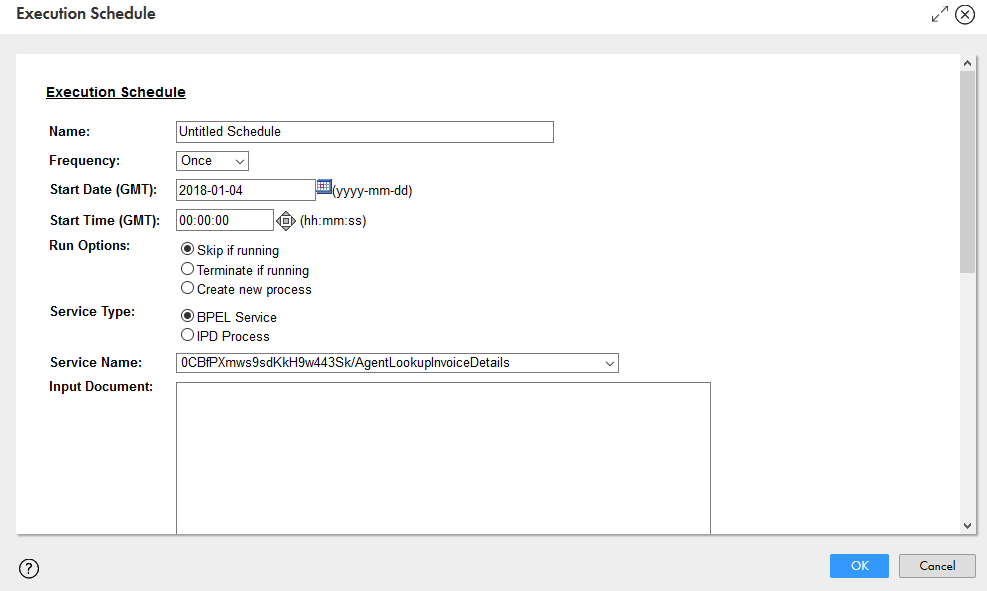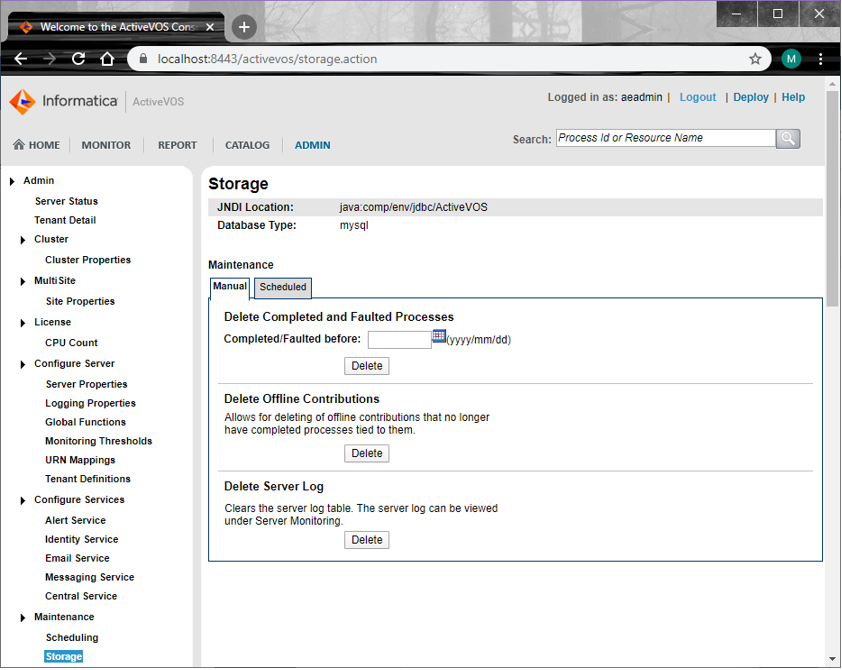Maintenance
After selecting this command, the following page is displayed:
Maintenance topics are as follows:
- •Scheduled Processes
- •Creating a New Process Schedule
- •Managing and Modifying Execution Schedules
- •Storage
Scheduled Processes
A BPEL process may be created to perform routine maintenance or other recurring task. If desired, you can deploy the process and then set a schedule to run it, such as weekly or on a specific day of the month. You can set a fine-grained schedule (intraday, seconds), if desired.
View the Scheduled Processes page from the Admin > Maintenance > Scheduling menu.
The following table describes information you'll see on this page.
Field | Explanation |
|---|
Enabled | A checkmark next to a schedule name indicates the process is enabled for execution |
Name | Descriptive name of the schedule. For example, use the process name, with or without other descriptive details |
Service Name | A service from the Service Definitions list. Select the Service Name to view the service definition. Hover help displays the process name associated with the service. |
Last Status | Execution state of the active process, such as Completed or Running. Select the Status to view the Active Process Details page. Hover help displays the Process Id. |
Last Execution | Date and time of the last process execution, if any |
Next Execution | Date and time of the next scheduled execution, if the schedule is enabled |
In a clustered environment, one of the nodes acts as an scheduling master at any time. Scheduled processes are elected to run only on the schedule master node. The schedule node is elected based on the server that starts up first. Only if there is a drop in the cluster communications do other nodes choose to get elected as the schedule master. Also Process Server does not maintain a history of the execution of scheduled processes.
To create a scheduled process, click the Create Schedule link at the top of the page. Process Server displays a dialog box that is described in Creating a New Process Schedule.
See also Managing and Modifying Execution Schedules.
Creating a New Process Schedule
To create a scheduled process, click Add at the top of the Process Schedule page. You see the following dialog box:
Execution Schedule |
|---|
Name | Provide a name to appear in the schedule list. |
Frequency | - - Once. Select this to execute on the start date and time specified.
Tip: This option is good for running a test execution. You can then duplicate the details for a different execution schedule. - - Intraday. Multiple execution times within a day.
- - Daily, Weekly, or Monthly allow for fine-grained control of the frequency schedule
|
Start Date on Server | For one-time (Frequency = Once) execution, type in a date, or select the Date Chooser to enter a date. In the Date Chooser, select Now to enter the current day. |
Start Time on Server | The default is midnight (00:00:00). Type in a time of day, or select the Date Chooser to enter a time. In the Date Chooser, select Now to enter the current time. |
Schedule Options | - - For Intraday, select a period of hours, minutes or seconds. Optionally enable the start and end hours.
- - For Daily, select Every Day (default), Every Weekday (M-F), or Every n days
- - For Weekly, select one or more days of the week. For example, select Monday to execute every Monday. Select Monday and Thursday to execute every Monday and Thursday. Optionally, specify a weekly execution frequency of 1 to n, where n schedules every 2nd, 3rd, or nth week, such as 12th week.
- - For Monthly, select a specific day, or select the first, second, third, fourth, or last day of the month. For example, select Last Monday to execute on the last Monday of the month. Tip: To execute on the last day of each month, enter a Day of 31. The correct last day of the month is adjusted. Select the months individually, if desired. By default, all months are selected.
|
Run Options | Select from the following options: - - Skip if previous still running (default). Does not schedule another process instance if the previous instance did not complete.
- - Terminate previous if still running. Terminates a previously scheduled execution prior to starting a new instance.
- - Always create new process . Schedules a new process execution regardless of the status of any prior executions.
|
Service Type | Choose whether the service is BPEL or IPD-based. |
Service Name/Select Service | If the service type is BPEL, type in a service name. Open the Service Definitions list to view names, then type in just the service name (without any extensions), such as myScheduledService. If the service type is IPD, select one of the services in the picklist. |
Input Document/POST Body | If the process is implemented using Process Developer and of BPEL type, follow either of the below steps: - - If the process implements a SOAP interface, enter the SOAP input message data contained within the SOAP Body Element, that is, the XML input message used to invoke the process. The data must conform to the WSDL interface of the process.
- - If the process implements a REST interface, you first need to create a SOAP wrapper for the REST service. Then, follow the instructions above.
If you use Process Designer to implement the process and the process is of the Informatica Process Definition (IPD) type, enter the JSON body of the POST message used to invoke the process. |
After you enter this information, Process Server creates a new scheduled process and you see that it appears in the Scheduled Process page.
See also Managing and Modifying Execution Schedules.
Managing and Modifying Execution Schedules
Use the icon, check box, and drop-down list of the Process Schedules list to manage the list.
Field | Explanation |
|---|
Pencil icon (Edit) | Select the pencil icon edit the schedule |
Select/Select All | Select an individual execution schedule or select the Select All check box to run, duplicate, delete, enable, or disable the schedule |
Run Now | Execute the selected processes |
Duplicate | Duplicate selected schedules. Initially the new schedules are disabled. |
Delete | Delete the selected execution schedules, including all details |
Enable/Disable | Enable or disable the selected execution schedules. If you enable a schedule, the process executes at the next execution time. Tip: A disabled schedule may still be executed immediately (Run Now), duplicated, or deleted. |
Storage
Note: You only see this command if you have selected an agent.
Process Server includes persistent storage based on the database settings you configured during installation. You must configure a database before running the engine.
The Storage page displays database configuration properties and allows you to maintain the database.
The displayed properties are:
Property | Explanation |
|---|
JNDI Location | The Java Naming and Directory Interface (JNDI) context that specifies where to look for the database. For example,jdbc/ActiveVOS |
Database Type | The type such as mysql. For a list of supported types, see the “Prerequisites” topic in Process Server Install, Configure, and Deploy in this help. |
User Name | Username, if required, for Process Server’s access to the database |



